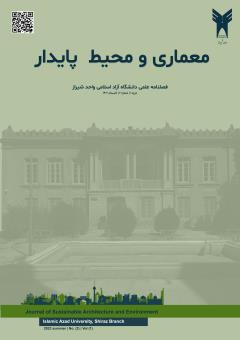Accessibility, mobility and transportation criteria in locating tourist-accommodation centers (case study: finding the location of a hotel in Shiraz using the ANP method)
Subject Areas : َArchitecture
koorosh Bolvaryzadeh Dashtestani
1
![]() ,
Amineh Andjomshoaa
2
*
,
Amineh Andjomshoaa
2
*
![]()
1 - Department of Architecture, Kerman Branch, Islamic Azad University, Kerman, Iran
2 - Department of Architecture, Kerman Branch, Islamic Azad University, Kerman, Iran
Keywords: Location detection, Hotel, ANP, Transportation, SuperDecision,
Abstract :
In the realm of architectural design for hotels, it is not only imperative to consider the aesthetics and layout, but also to carefully choose the most fitting location for its intended purpose. In metropolitan areas, hotels are typically constructed in affluent districts or the heart of the city, yet have received minimal scrutiny from researchers regarding their placement. Various factors come into play when determining the optimal site for a hotel, including but not limited to transportation, geographical features, legal and socio-cultural aspects, psychology, building density, regional expansion, cost, and population. These factors are collectively known as location criteria, with each criterion having one or more subsets that are subjected to ANP analysis. The ANP approach is an invaluable tool in identifying the most suitable location for a hotel. Within this piece, one location is selected from three options based on displacement, transportation, and accessibility criteria. The potential of each site is initially evaluated, and images of the areas are created via Photoshop software. Subsequently, the SuperDecision program is leveraged, using the ANP methodology for scoring, selection, and presenting outcomes in various tables and super matrices. Ultimately, the optimal site for a hotel is identified in Shiraz, which ranks among the most populous cities in Iran. This chosen site is situated on Modares Blvd. and boasts several key advantages, which include proximity to the city center, post office, major shopping malls, airport, metro and city bus stations, banks, natural history museum, passenger terminals, Shiraz University of Technology, and various health and treatment centers. As a suggestion, it would be worthwhile to delve further into other location criteria, such as geographical features and operational management, among other key factors.
پاپلی یزدی، محمدحسین و مهدی سقایی (۱۳۸۵): گردشگری (ماهیت و مفاهیم)، انتشارات سمت، چاپ دهم، تهران
سهرابی، بابک، طهماسبی¬پور، کاوه, رئیسی وانانی، ایمان و صفر فضلی (بهار 1391): «شناسایی معیارها و تبیین مجموعههای فازی انتخاب هتل از دیدگاه گردشگران مقیم تهران »، پژوهش¬های جغرافیای انسانی، شماره 79، صص 55-74
قاسمي فروغ، زياري كرامت اله و محمد صادقی (تابستان 1393): « تحليل کيفي و مکاني مراکز اقامتي شهر شيراز جهت توسعه گردشگري (با تاکيد بر هتل ها) »،جغرافیا و آمایش شهری، شماره 11، صص 1-13
محلاتی، صلاح الدین (۱۳۸۰): درآمدی بر جهانگردی، انتشارات دانشگاه شهید بهشتی،چاپ اول، تهران.
AYTAÇ ADALI, E., TUŞ IŞIK, A., & KUNDAKÇI, N. (2015). TOURIST HOTEL LOCATION ION WITH ANALYTIC HIERARCHY PROCESS. Journal of Life Economics, 2(3). doi: 10.15637/jlecon.82
Cresswell, J. (2021). Oxford Dictionary of Word Origins. In Oxford Dictionary of Word Origins. doi: 10.1093/acref/9780198868750.001.0001
Ghorui, N., Ghosh, A., Algehyne, E. A., Mondal, S. P., & Saha, A. K. (2020). Ahp-topsis inspired shopping mall site selection problem with fuzzy data. Mathematics, 8(8). doi: 10.3390/math8081380
Habibi, T., Ponedelnik, A. A., Yashalova, N. N., & Ruban, D. A. (2018). Urban geoheritage complexity: Evidence of a unique natural resource from Shiraz city in Iran. Resources Policy, 59. https://doi.org/10.1016/j.resourpol.2018.06.002
Mohammadpour, A., Emadi, Z., Samaei, M. R., Ravindra, K., Hosseini, S. M., Amin, M., Samiei, M., Mohammadi, L., Khaksefidi, R., Zarei, A. allah, Motamed-Jahromi, M., & Mousavi Khaneghah, A. (2022): The concentration of potentially toxic elements (PTEs) in drinking water from Shiraz, Iran: a health risk assessment of samples. Environmental Science and Pollution Research, 0123456789. https://doi.org/10.1007/s11356-022-23535-2
Najafi A. Structure and Environmental Challenges Analysis in Projects Management Using Analytical. Journal title 2010: 21 (1) :63-76. URL: http://ijiepm.iust.ac.ir/article-1-244-fa.html
Popovic, G., Stanujkic, D., Brzakovic, M., & Karabasevic, D. (2019): A multiple-criteria decision-making model for the selection of a hotel location. Land Use Policy, 84. doi: 10.1016/j.landusepol.2019.03.001
Sadiq, M., Khan, S., & Mohammad, C. W. (2022): Selection of software requirements using TOPSIS under fuzzy environment. International Journal of Computers and Applications, 44(6). https://doi.org/10.1080/1206212X.2020.1820689
Sadiq, M., Parveen, A., & Jain, S. K. (2021): Software Requirements Selection with Incomplete Linguistic Preference Relations. Business and Information Systems Engineering, 63(6). https://doi.org/10.1007/s12599-021-00696-x.
Ulucan, E. (2020): The Hotel Site Selection: Determining Locational Factors by Fuzzy TOPSIS. European Journal of Tourism, Hospitality and Recreation, 10(3). doi: 10.2478/ejthr-2020-0019
Wu, M., Pei, T., Wang, W., Guo, S., Song, C., Chen, J., & Zhou, C. (2021): Roles of locational factors in the rise and fall of restaurants: A case study of Beijing with POI data. Cities, 113. doi: 10.1016/j.cities.2021.103185

